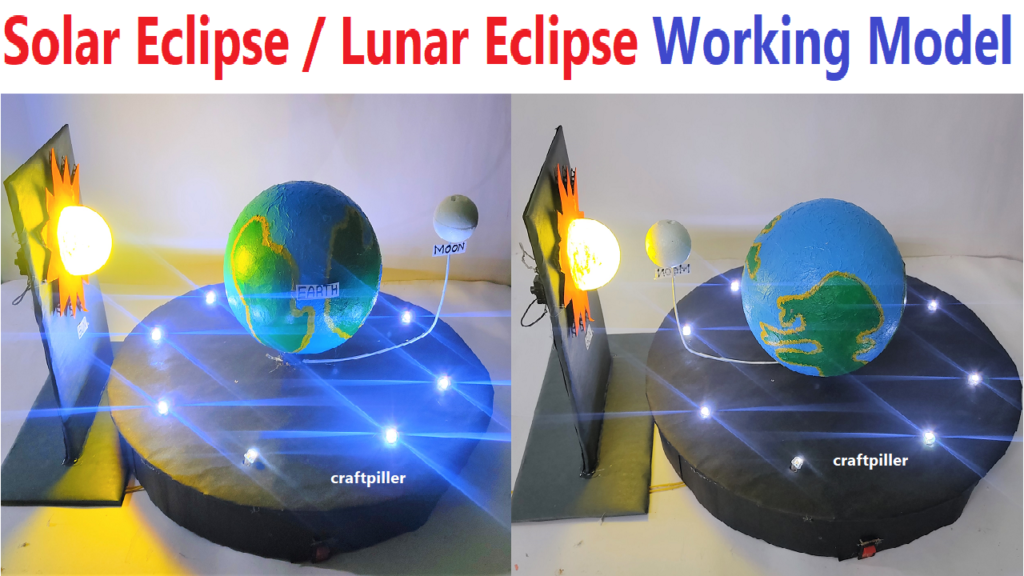Solar and lunar eclipses are fascinating celestial events that occur when the Earth, the Moon, and the Sun align in specific ways, causing one celestial body to partially or completely block the light from reaching another.

Here’s an explanation of each:
- Solar Eclipse: A solar eclipse occurs when the Moon comes between the Earth and the Sun, blocking some or all of the Sun’s light from reaching the Earth. There are three types of solar eclipses:
- Total Solar Eclipse: This occurs when the Moon completely covers the Sun, creating a dark shadow (called the umbra) on the Earth’s surface.
- Partial Solar Eclipse: In a partial solar eclipse, the Moon partially covers the Sun, casting a shadow called the penumbra on the Earth’s surface. From certain regions on Earth, the Sun appears partially blocked by the Moon, creating a crescent-shaped appearance.
- Annular Solar Eclipse: An annular solar eclipse happens when the Moon is at a farther point in its orbit and appears slightly smaller than the Sun. As a result, during the maximum phase of the eclipse, a bright ring (annulus) of the Sun is visible around the dark disk of the Moon.
2.Lunar Eclipse:
A lunar eclipse occurs when the Earth comes between the Sun and the Moon, causing the Earth’s shadow to fall on the Moon’s surface. There are two types of lunar eclipses
Total Lunar Eclipse: In a total lunar eclipse, the Earth’s shadow completely covers the Moon, turning it a reddish or coppery color. This phenomenon is often referred to as a “Blood Moon.” During a total lunar eclipse, the Moon passes through the Earth’s inner shadow (umbra).
Partial Lunar Eclipse: In a partial lunar eclipse, only a part of the Moon enters the Earth’s shadow, causing a portion of the Moon to darken.
Step by Step Video Making of the Lunar and Solar Eclipse Working Model
In this project, we’ll build an interactive model to demonstrate solar and lunar eclipses using cardboard, LED lights, small white balls for the moon, a decorated football for the Earth, a separate vertical attachment with LED lights as the sun, and a slow-running motor for the Earth/moon rotation. Here are the steps:
Materials Needed:
- Cardboard sheets (for circular space)
- Small LED lights (for stars)
- Small white ball (to represent the moon)
- A football (to represent the Earth)
- Paints or markers (for decorating the Earth)
- A separate vertical attachment with LED lights (as the sun)
- A slow-running motor with switch
- Power source for the motor (e.g., battery pack)
- Wires and connectors (for the electrical connections)
- Glue or adhesive
- Small gears or pulleys (optional, for mechanical advantage)
Building the Eclipse Working Model:
1. Creating the Circular Space:
Step 1: Cut out a large circular piece of cardboard to serve as the backdrop for your space.
Step 2: Poke small holes in the cardboard to represent stars. Insert LED lights into these holes to create a starry background.
2. Preparing the Earth and Moon:
Step 3: Decorate the football (representing the Earth) with paints or markers to depict continents, oceans, etc.
Step 4: Attach small white balls (representing the moon) to the circular space using thin wires or sticks. These should be movable to simulate the moon’s orbit around the Earth.
3. Setting Up the Sun:
Step 5: Create a separate vertical attachment using cardboard to represent the sun. Attach LED lights to it for a glowing effect.
4. Building the Base:
Step 6: Cut out a rectangular piece of cardboard to serve as the base. Attach the Earth, moon, and sun to this base.
5. Adding the Rotating Mechanism:
Step 7: Attach a slow-running motor to the base of the model. Position it in a way that it can rotate the Earth and moon.
Step 8: Connect the motor to a switch for on/off control.
Step 9: Connect the motor to a power source (e.g., battery pack).
Optional: You can use gears or pulleys to create a mechanical advantage and ensure smoother rotation.
6. Demonstrating Solar and Lunar Eclipses:
Step 10: Turn on the motor using the switch. This will start the rotation of the Earth and moon.
Step 11: As the Earth and moon rotate, observe how solar and lunar eclipses occur. Use the LED lights to simulate the eclipse phases.
7. Labeling and Detailing:
Step 12: Label each phase of the eclipses (Partial Solar Eclipse, Total Solar Eclipse, Partial Lunar Eclipse, Total Lunar Eclipse) on the respective parts.
Your solar/lunar eclipse working model with a rotating Earth and moon is now complete! This dynamic model provides a visual representation of how solar and lunar eclipses occur due to the alignment of the Earth, moon, and sun.
It’s an engaging educational tool for learning about these celestial events with an added element of interactivity.

